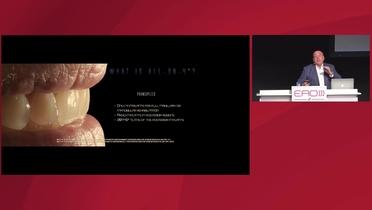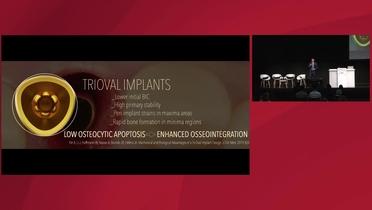Digital Innovation to Achieve Better Results
Video highlights
- The digital workflow
- How to collect the relevant data
- How to combine and utilize the available data
Dentists today strive to achieve three main goals in their implant treatments. Long recognized as crucial factors in implant health, these goals include prosthetic-driven implant placement and biologically-driven implant placement. And most relevant to patients, these goals include esthetic-driven implant placement. Dr. Renaud Noharet discusses how can digital innovations and tools support these goals of modern dental implantology practitioners.
The successful integration of digital tools into daily dental practice begins with the step of data collection or data acquisition. This initial step determines all subsequent treatment steps and, ultimately, the treatment outcome. To collect the necessary data, Dr. Noharet employs various tools, beginning with the initial CBCT scan to generate DICOM files, followed by intra-oral scanners to provide STL files, and finally, a digital camera to capture JPG or MPEG files. These JPG or MPEG files add the clinical view to the technical files of imaging, delivered through DICOM and STL files. The combination of these files is referred to as the "digital workflow," which encompasses both technical and clinical perspectives, creating a digital clone of the patient. Dr. Noharet stresses the importance of all elements in achieving a good diagnosis and effective treatment planning and execution. The data collection process takes approximately 12 minutes, and Dr. Noharet remarks that this is a worthy investment given its positive impact on overall treatment time.
Once the digital clone of the patient has been created, Dr. Noharet proceeds to the next stage, which is treatment planning. Thanks to the array of digital tools available, treatment planning is a quick, easy-to-use, and efficient process. During his lecture, Dr. Noharet cites DTX Clinic as being invaluable in facilitating fast and straightforward treatment planning. The software consolidates all relevant patient data and supports the clinician during diagnosis and treatment planning. Artificial intelligence aids in the planning of both the implant surgery, i.e., the implant positioning, and the prosthetic treatment, i.e., the design of the restoration. Because an implant treatment involves both the soft and hard tissue, the combination of effective prosthetic planning and implant planning work together to achieve the optimal treatment outcome.
In recent years, the evolution of digital tools has rendered the fabrication of a mock-up by a dental technician unnecessary for treatment planning. With the aid of software, the prosthetic can be designed seamlessly without the need for manual steps. Dr. Noharet emphasizes that both the software's and the dental technician's suggested design are identical, thus underscoring the power of artificial intelligence. The software can draw upon a vast database of patient data to develop the optimal prosthetic treatment design.
Dr. Noharet delves into the third topic of his lecture, execution, and discusses the various options available for implant placement, namely free-hand surgery, guided surgery, and navigated surgery. Reporting clinical evidence, guided surgery shows a 2.2 times higher accuracy rate, superior to free-hand surgery. This increased precision has a significant impact on treatment outcomes; optimal implant positioning leads to successful biological and prosthetic results. Dr. Noharet shares that he has transitioned to navigated surgery, performing all his implant placements using this approach. He acknowledges that this shift from guided to navigated comes with a learning curve, as the clinician must shift their focus from the patient's mouth to the screen that guides them during the surgery. Over the past four years, Dr. Noharet has completed over 560 surgeries in his practice using the navigated approach. He uses this approach with every patient in his clinic, remarking that a technique that is applied daily improves treatment efficiency and quality. The predictability and efficiency of navigated surgery (X-Guide, Nobel Biocare) allows Dr. Noharet to focus on the other aspects of the treatment, e.g. a soft tissue graft.
Dr. Noharet illustrates the complete workflow from data collection over treatment planning to execution with a case presentation and summarizes the key benefits of navigated surgery:
Autonomy: the absence of a surgical guide results in greater efficiency by skipping the steps of its design – validation – fabrication in the treatment process.
Simplicity: navigated surgery is easy to implement. The dental assistant can support the validation step allowing the clinician to focus on the surgery.
Fully digitized workflow: with all the digital tools available and their daily use, there are few limitations to which patients can be treated.
When determining the success of the restoration, focusing solely on aesthetic results is insufficient. Similar to other colleagues, Dr. Noharet employs tens (Transcutaneous Electrical Neural Stimulation) and neuromuscular dentistry to ensure that the occlusion is properly addressed. Occlusion is a crucial element to be considered, key to a successful restoration.
To deliver our patients high-end results in terms of esthetics, biology, and prosthetics, it is undisputed that the ideal position of the implant plays a very important role. By diligently following all steps and by successfully utilizing the digital workflow, dentists can achieve optimal treatment outcomes with greater efficiency and predictability. Realizing a fully digital workflow aids clinicians today in achieving prosthetic, biological, and esthetic goals of implant treatment.
Reference
[1] Jung RE, Schneider D, Ganeles J, Wismeijer D, Zwahlen M, Hämmerle CH, Tahmaseb A. Computer technology applications in surgical implant dentistry: a systematic review. Int J Oral Maxillofac Implants. 2009;24 Suppl:92-109. PMID: 19885437.


